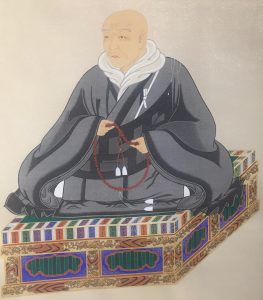
Summer is for ghost stories in Japan, sending chills down spines on hot summer nights. Consider this ghost story involving Shinran Shonin.
Shinran normally isn’t connected to the supernatural, however many legends abound about the founder of Jodo Shinshu Buddhism belonging in the realm of unbelievable. For example in the Japan countryside where he was exiled, a tree stands today supposedly that grew from a walking stick that Shinran dropped.
Ryoei Nanjo, adjunct lecturer at Musashino University in Tokyo, argues that legendary stories, while factually untrue, have much to teach us in understanding the propagation of Shin Buddhism. At the International Association of Shin Buddhist Studies (IASBS) Biennial Meeting in Taiwan in May, he presented a paper titled, “An Examination of Shin Propagation in Terms of Legendary Stories Told About Shinran.”
Legends about Shinran are especially prevalent in the Kanto region of Japan, where Shinran traveled and met with many people, eventually resulting in a group of top disciples known as “Twenty-four disciples of Shinran” (Japanese: Nijyuyohai). According to Nanjo, groups and traditions established by them grew during the Edo period (1603-1868) and ordinary people began embarking on pilgrimages, exhorted by Shin followers to learn more about Shinran by cherishing memories of him. As a result, various legendary stories about him grew in popularity.
Nanjo sees a connection between a ghost story involving Shinran and a well known tale called “A Ghost Caring for Her Baby” (Japanese: Kosodate yurei). This second story, a Japanese folktale circulated during the Edo period, has been used by Buddhist priests talking about the kindness of parents to their children, and also in rakugo, Japanese comedic storytelling. In Kyoto’s Higashiyama district, there are even candies sold based on the story.
This ghost and baby story begins with a shopkeeper closing shop on a dark rainy night, when he sees a pathetic looking woman standing outside. She asks for “one candy please,” and pays with a small coin. She appears again night after night, until she is unable to pay. She offers her coat for the candy, and forces it on the protesting shopkeeper. Stopping by the shop the next day, a merchant recognizes the coat and tells the shocked shopkeeper that it belonged to a woman who had just passed away.
The story goes on to describe how they immediately seek the advice of a local priest who reprimands them for believing in superstitions. Together they all visit the graveyard where the woman was buried and discover a surprising result. Read Nanjo’s paper if you want to know how the story ends.
The story about Shinran and a ghost also involves a woman who has died. Villagers believed her ghost haunted the grounds of a local temple, where no priest would take up residence. When Shinran passed by the village, they asked him for help. This story also is included in the paper.
Nanjo acknowledges certain elements of these stories misrepresent Jodo Shinshu teachings, for example when nenbutsu, reciting Amida Buddha’s name, is used as a form of magic. He wrote, “Although these stories are heretical interpretations of the doctrine, they did spread widely in the Kanto region and were handed down to contemporary society…” Nevertheless, these stories play an important role in propagation and, in some ways, address people’s suffering, he says.
Other papers presented at the IASBS meeting are available here.
–Rev. Ken Yamada, editor, Shinshu Center of America

